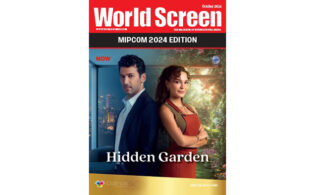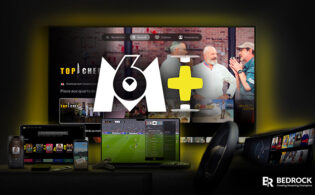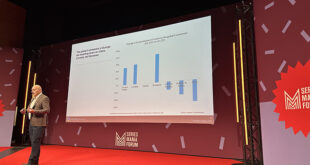Backed by RTL Group, Bedrock is positioning itself as a strategic streaming partner for broadcasters looking to maximize their revenues from the digital economy. Most recently, Bedrock worked with M6 to build its new AVOD platform, M6+, a service that is part of the French broadcasting group’s efforts to triple its streaming revenues by 2028. Jonas Engwall, the CEO of Bedrock, talks to World Screen about the upcoming new service, the company’s flexible technology solutions and broader trends in the streaming landscape.
WS: Tell us about the deal with M6 for M6+, its new AVOD platform.
ENGWALL: The launch of M6+ will be a significant upgrade for 6play users. We’re leveraging Bedrock’s technology with entirely new innovative features and upgrades that our other clients already use. This is a massive upgrade of the existing M6 platform, albeit not building an entirely new infrastructure.
If you look at the French market, historically and up until recently, it was very telco-heavy, with half the viewing happening through telco boxes, leading to sometimes unsynchronized experiences. For example, if you were watching on your mobile and came home to your telco box, “resume watching” would not be synchronized.
M6 used to be a paid service on smart TVs, accessible on Samsungs and LGs—all big screens—via 6play max. Now, M6+ is going fully direct-to-consumer in an AVOD model, allowing users to stream on any device with the same cutting-edge user experience. This enhanced user experience is just the beginning.
M6+ offers a free ad-supported tier alongside a premium option with more features. We’re also dramatically expanding the feature set around an enriched video experience, with a focus on interactivity and engagement for sports (with UEFA EURO 2024) and entertainment shows. Stories integrating social features to attract younger audiences will also be at the forefront of those innovations. Innovations will go beyond video, as M6+ will feature a brand-new generative AI search engine you can talk to—for example, “Find a 20-minute show for my 8-year-old daughter”—and integrate hundreds of podcasts from M6’s popular radio division. This comprehensive upgrade positions M6+ as a top-tier direct-to-consumer streaming platform.
WS: How does your long-standing association with M6 speak to the ways in which Bedrock can cater to all of a broadcaster’s streaming solution needs?
ENGWALL: Even the biggest players in the U.S. understand the importance of scale. We at Bedrock recognized this back in 2019. As a European com¬pany, we knew competing with global giants on muscle alone wouldn’t be sustainable. We needed a smarter approach—pooling resources and building scale across borders with multiple clients. Scaling within one European country simply wouldn’t cut it in the tech world. That’s the core principle behind Bedrock: creating a platform with scale beyond any single nation.
When we showcase our solutions, there’s a common misconception that all platforms will look identical to others we’ve built. But that’s not our promise. We prioritize flexibility. Every partner wants a unique look and feel—that’s the starting point. We then work backward, finding numerous core functionalities that can be standardized into a “core approach” applicable to everyone. This central framework provides a solid foundation upon which we build customized user interfaces. Think of it like plumbing in a house—everyone needs it, but the aesthetics and layout of the house itself are distinct.
This philosophy extends beyond aesthetics. We consider Bedrock as a strategic streaming partner, versus a tech vendor. M6 exemplifies this approach. They can leverage our expertise to build features they couldn’t develop independently. For instance, M6 will be the first Bedrock partner to launch podcasts. As we develop this feature, it becomes part of our overall offering. We foster continuous engagement with partners through regular product advisory board meetings. Other partners can then learn from M6’s podcast experience, including performance metrics, user adoption rates and the impact on traffic to other assets, allowing for the seamless integration of this feature into their own platforms. This collaborative approach fos¬ters knowledge-sharing and increases agility for all partners. Others could say that M6 has already tested and proven the effectiveness of podcasts and I can implement it in my market without the initial investment of time and resources. This approach allows for customization and efficiency, ultimately leading to a stronger streaming ecosystem for our clients.
WS: We’ve seen many streamers evolve their revenue models. How has that shift to greater flexibility and more ad tiers affected your approach to potential clients?
ENGWALL: Our multiple-client angle with various business models allows for a powerful hybrid approach to streaming. M6 is a clear example of an AVOD platform. Meanwhile, the Netherlands’ Videoland leans heavily toward SVOD. Here’s the beauty of Bedrock: We can cater to both models.
Currently, all our clients utilize a hybrid approach. Take the Netherlands again; although predominantly SVOD, we give them the flexibility to operate in both worlds, incorporating an ad-supported content model to diversify their revenue streams.
This flexibility goes beyond platform type. Our tools empower partners to create different subscription tiers and experiment with what works best for their audience. This fosters valuable knowledge-sharing between partners. The French team at M6, with less experience in SVOD, can learn from the Dutch team at Videoland and vice versa. They’re not competitors but collaborators in a shared environment. The value of peer-to-peer learning in this context shouldn’t be underestimated. Free-to-air broadcasters, for instance, might be intrigued by SVOD as a novel revenue stream.
However, a complete shift to SVOD isn’t always practical. Here’s where the hybrid model shines—they can offer an SVOD component alongside their core AVOD platform.
The industry recognizes that while SVOD offers a fresh revenue stream, AVOD remains a powerful engine for generating income. A hybrid approach allows broadcasters to tap into the best of both worlds, ultimately strengthening their overall revenue structure.
WS: What role does FAST channel delivery play in your tech solutions? Is this something you’re seeing broadcasters lean into?
ENGWALL: We currently provide FAST technology for M6, so this model is available to all our clients. For other strong streaming players, FAST makes perfect sense. FAST channels can be produced in a smarter way, essentially streamlining the production process without impacting the viewer experience. This approach allows broadcasters to deliver content efficiently, and I think more smart and personalized FAST channels will happen in the future.
WS: What are your priorities for Bedrock amid this challenging time in the media business?
ENGWALL: Bedrock was formed in 2020, but the expertise and streaming skills go back 15 years. We recognized early on the necessity of pooling resources and creating scale to compete in the global market. Back then, some had the luxury of getting large budgets from their boards for digital and technology. This led some to believe they could secure heavy funding independently. But the tide is turning. As budgets tighten and the streaming landscape becomes more competitive, Bedrock’s value proposition becomes increasingly clear. Our focus is on these potential partnerships with major players (we have some big names lined up) as we prepare for significant growth. We’re witnessing a confluence of factors driving this shift. The industry is maturing, players are recognizing the complexities of streaming, and financial constraints are forcing a reevaluation. This is leading some big media companies to reconsider their approaches.
The future of streaming is a positive one for Bedrock. While the market seems challenging, I firmly believe local stories will continue to hold tremendous value. Global giants play a role, but they cannot replicate the depth and connection offered by local narratives. Local storytelling will increasingly move to streaming platforms.






